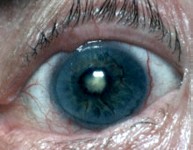 Myopia Myopia is nearsightedness. The lens can't focus properly on distant objects (you can only focus on things that are near). Distant objects actually come to a focus inside the eye too far in front of the retina. This can be corrected by placing an artificial concave lens in front of the eye, which spreads the light a little and allows the eye's lens to focus it properly on the retina.  A laser can also be used to sculpt the cornea so its shape mimics the shape of concave corrective lenses, making the use of eyeglasses for nearsightedness unnecessary. Hyperopia Hyperopia is farsightedness. The lens can't focus properly on nearby objects (you can only focus on things that are far). Nearby objects actually come to a focus inside the eye too far behind the retina. This can be corrected placing an artificial convex lens in front of the eye, which converges the light a little and allows the eye's lens to focus it properly on the retina.  Astigmatism If the shape of the eye or the shape of the lens itself is not spherical, the result is that the eye can focus on vertical lines in images, but not on horizontal ones. This will result in a slightly blurry image. This can be corrected by placing an artificial spherical lens in front of the eye. Cataracts 
Cataracts are regions of cloudiness inside the lens of your eye. This cloudiness makes it more difficult for light to get through the lens, and results in blurry vision and poor night vision. Everyone will eventually get cataracts as they age, although the condition is not caused by reading too much, but rather by a breakdown of the tissue of the lenses as they age, or because of disease. The only treatment is to have the cloudy regions surgically removed and replaced by artificial lenses. Glaucoma Glaucoma is a disease of the optic nerve that may be caused by pressure inside the front of the eye. The liquid called the aqueous humor that fills the front of your eye (mostly between the cornea and lens) is constantly being replenished, but if the drainage tube for this liquid is blocked, the fluid pressure inside the entire eye may increase, causing damage to the optic nerve and resultant blind spots. Often people don't notice these blind spots until too much optic nerve damage has already occurred. Damage can't be repaired, but treatment can prevent further nerve damage; if the entire nerve is destroyed, blindness is the result. Floaters Floaters are the little specks that seem to float about in your field of vision when you look at something bright or solidly light in colour. They are small, shadowy shapes that can look like spots, threads, or squiggly lines. They move as your eyes move, but always jump away when you try to look at them directly. They usually continue to drift around when your eyes stop moving. Eventually floaters will settle at the bottom of the eye, below the line of sight. Floaters occur when the vitreous humour, the clear gel that fills the main part of the eye, slowly shrinks. As it shrinks, it becomes a little bit 'stringy', and the strands that float around can cast tiny shadows on the retina. Generally floaters are harmless. Floaters are more likely to occur in older people, but are also more common in people who are very nearsighted, have diabetes, or who have had a cataract operation. Detached Retinas A retinal detachment occurs when part of the retina is lifted from its normal position at the back wall of the eye. This can often be caused by an injury to the head. If untreated, detached retinas can lead to permanent visual impairment or complete blindness. Fortunately, the retina can be reattached by 'welding' it back into place with a laser. |